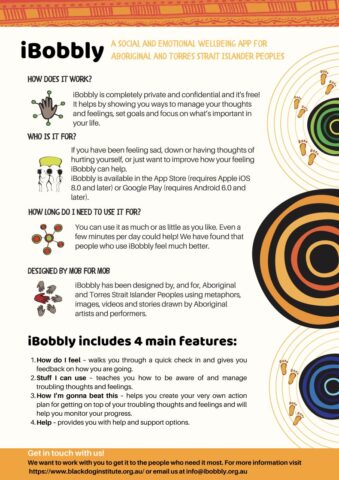How does it work?
iBobbly has four main features:
- How do I feel – walks you through a self-assessment and gives you feedback about how you are going. Allows you to keep a mood diary to see how you are tracking.
- Stuff I can use – teaches you how to manage your thoughts and feelings, including any suicidal thoughts. This section also helps you to identify the characteristics you want to stand for and encourages you to set realistic, positive goals.
- How I’m gonna beat this – helps you create your own personalised action plan and gives you the tools to monitor your progress.
- Help – provides you with help and support options.
Who’s it for?
iBobbly is specifically designed for Aboriginal and Torres Strait Islander peoples who:
- are aged 15 years and older
- are feeling sad and down
- might be having thoughts of hurting yourself.
- have access to a Smart phone or Tablet/iPad and data for downloading.
What’s the commitment?
Using iBobbly for just six weeks has been shown to reduce depression, distress and suicidal thinking.
Once you have downloaded the iBobbly app, you can use iBobbly as much or as little as you like.
What’s the evidence?
iBobbly was first tested in a randomised controlled trial involving 61 Aboriginal people from the Kimberley, WA. Users reported significantly lower levels of depression and psychological distress. iBobbly was well received by people who tried it and feedback from users was positive.
The full results of the trial were published in the British Medical Journal (Open) in March 2017 and can be accessed here.
A second, large-scale trial concluded in August 2019 and involved six locations around Australia and over 400 participants. Preliminary results are positive and expected for release in 2020.
iBobbly’s design and development
Most of the artwork within the iBobbly app was designed by local artists in Broome, Ms Martha Lee, Ms Danica Manado and Ms Esah Coffin created new imagery to represent different ideas within the app. Some examples of these images are presented below.
The language used in the app was chosen in consultation with the young people in Broome, and other suggestions on the type of language that young people would respond to were incorporated into the app. In addition, most of the local voiceover talent was recorded by Goolarri Media in Broome for the first trial. There are two versions of the app, one featuring a young male voice, and the other a young female voice, who guide users through the activities of the app.
Information for health professionals
Most of the learning content within iBobbly is based on Acceptance and Commitment Therapy and Cognitive Behavioural Therapy.
Information and resources for health professionals coming soon.
Funding
iBobbly has been made possible with funding support from:
- Australian Government Department of Health
- NSW Mental Health Commission
- nib Foundation (current funding partner)
- Mostyn Foundation (current funding partner)
- Matana Foundation for Young People (current funding partner)
- AON
- Samsung
iBobbly collaborators, design and development
iBobbly began as a partnership between Black Dog Institute, ALIVE & Kicking Goals! and Men’s Outreach Service Inc based in Broome, WA.
Most of the artwork within the iBobbly app was designed by local artists in Broome, Ms Martha Lee, Ms Danica Manado and Ms Esah Coffin created new imagery to represent different ideas within the app. Some examples of these images are presented below.
The language used in the app was chosen in consultation with the young people in Broome, and other suggestions on the type of language that young people would respond to were incorporated into the app. In addition, most of the local voiceover talent was recorded by Goolarri Media in Broome for the first trial. There are two versions of the app, one featuring a young male voice, and the other a young female voice, who guide users through the activities of the app.







